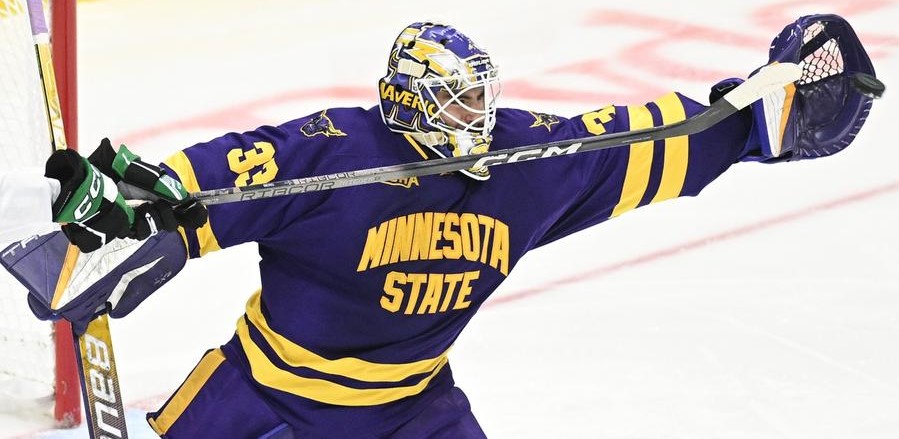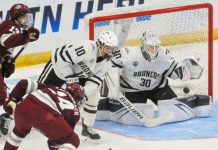
Each week during the season, we look at the big events and big games around Division I men’s college hockey in Tuesday Morning Quarterback.
Dan: A hearty good Tuesday to everyone, and before we begin anything, a special Thanksgiving wish to all of us living in this Hockey Town… not Hockeytown, which is where most of us in Massachusetts probably spent Thanksgiving weekend when we were kids (the building is somehow still standing…if you know, you know).
Even more so, a Happy Thanksgiving to you, Paula. I wish nothing but the best for you and your loved ones!
There’s plenty thanks to hand out in college hockey this weekend, and for us, the biggest is probably to Arizona State, which handed Denver losses for the first time this season. Beyond cracking champagne for Cornell’s perfect 1970 team and although there’s still an undefeated team lurking at Dartmouth, I couldn’t believe that the Sun Devils actually beat the defending national champions in the altitude – not once but twice. As a result, for the first time this season, we have ourselves a new No. 1 in the form of Michigan State.
Plenty of meat on this wishbone, but I’ll begin with what is the first No. 1 ranking for the Spartans since the 2006-07 team beat Boston College in the national championship. I can’t remember a time when they were ranked atop the polls during a season – they were No. 2 to start the 2007-08 year – but I’m pretty sure it might’ve been 20-plus years dating back to the 2001-02 team that started the year No. 1 at a time when a young and burgeoning U.S. College Hockey Online site was in its infancy hosting a poll.
Watching the rise of this team under Adam Nightingale still impresses me, but as a Michigander, what’s this team looked like up close and why is it deserving of the No. 1 slot now that Denver’s finally faltered?
Paula: So much to unpack here, Dan.
Before getting into what makes Michigan State so good this year – and worthy of that No. 1 spot – I want to talk about why Denver was demoted immediately after the Pioneers’ first slip of the season.
In two words: what gives?
Is it because the Pioneers are now 2-2-0 in NCHC play? Everyone in the NCHC is at or near .500 in conference play with the exception of Miami, winless in six games. Do poll voters now view the NCHC as a conference with so much parity that league losses are a sign of weakness?
Is it specifically because it’s a sweep at home, and specifically because Arizona State delivered that sweep? If so, then the message is as much about what voters think of ASU as they do of DU.
Is it the way they lost, with Artem Shlaine scoring the game-winning goal for the Sun Devils in the final minute of regulation and just four minutes after Carter King had tied the game for the Pioneers in the Friday game and the way Arizona dominated Saturday?
Or is it because voters have been waiting for Denver to slip and jumped on the chance to mix things up at the top?
Full disclosure: I am one of the seven people who put the Pioneers at the top of the ballot. I have Minnesota second, Michigan State third, Boston College fourth, Maine fifth. Any one of those teams is worthy of the top spot, imo, and the criteria for where people vote them seems arbitrary to me.
I’m not arguing that Michigan State doesn’t deserve the No. 1 ranking, and I do think it has something to do with the perception that the Spartans have taken care of business when Denver, Minnesota and BC have not. An argument can be made that the Pioneers should have beaten Arizona State, and that’s what cost them. An argument can be made that if Minnesota had swept Bemidji State two weeks ago, the Golden Gophers would be in that top spot.
Maybe Boston College never should have lost to Northeastern. Now both Maine and Michigan State have something important in common. The only losses they’ve suffered are to Boston College.
Okay. Now that I’ve gotten that out of my system, onto your question about these very good Spartans.
Michigan State is not stratospheric. The Spartans in the mix with the top five to eight teams in the poll. What separates them is their consistency and their ability to improve from week to week.
What Adam Nightingale and his staff have accomplished in a very short time is beyond impressive, but a lot of credit goes to the players who immediately bought into Nightingale and his staff, who changed the way everything is done at Michigan State.
After being blanked by Boston College Oct. 11, the Spartans have scored four or more goal in every contest since with the exception of their 3-0 win over Canisius Oct. 25. That span includes their second game against the Eagles, which they won 4-3.
To see them among the top 10 teams in the country for offense is pretty amazing, given where they were a few years ago. Nightingale will tell you himself that it’s a team effort. The Spartans are averaging 3.80 goals per game and 14 different players have contributed to the goals count. Defensively, they’re seventh in the nation (1.80), and starter Trey Augustine (1.89 GAA, .931 SV%) is as solid as they come. Michigan State’s combined special teams needs a bit of work, but I guarantee it will improve significantly in the coming weeks – because that’s what Michigan State does.
Their steadiness and tenacity are crucial for improvement, and everyone there knows it. It’s especially important for them to make the most of the early season because the Big Ten will be hard fought this year. That is something I’m really looking forward to.
That was a long answer to your question, Dan, but two more things:
First, let’s not mislead people. I’ve been a Michigander since 2008, and I will happily own that label, but I’m a born and raised New Yorker and no amount of time in the Midwest will change that – as my friends here often lament.
As a Michigander, though, I’ve learned that the term “Hockeytown” carries a lot of baggage, and I’m not touching it.
Dan: OK, OK, fair enough. You bring up an interesting point about Denver, more specifically, because I feel like I had weekly arguments with college hockey friends and colleagues about how I constantly put the Pioneers into the No. 1 spot over a team like Boston College, which had arguably a better resume for its non-undefeated record. To that, I agree with DU not being as impressive, but I also refuse to send the No. 1 team out of its perch until it lost. Until BC dropped its game to UConn, that argument maybe held weight, but I also don’t think Denver, as the defending national champion, should have lost its top ranking until it lost a game.
My second criteria for Denver reflects back to the losses because I placed a tax on having lost at home to Arizona State. That’s not necessarily an insult to either team, but losing to a team that hadn’t been lighting the world on fire in the first month of the season outweighed how I started to look at the two-loss record. The way Denver fell in the Pairwise is an indication of how much those losses hurt, at least for now, and while I suspect the team will resurrect its No. 1 status, I also don’t necessarily believe that it’s the best team, right now, in college hockey, which is what No. 1 is usually an indicator for my voted-on poll.
As an aside, I voted Michigan State into the No. 1 spot, but I wished I could have tied my top two teams. More alarming for me was a placement of Boston College at No. 5, but the loss to Northeastern on Saturday night really hurt the team’s identity, at least for now. I think BC is a national championship contender, but losing twice in a week and to Northeastern is a big reason why I couldn’t keep my beloved Eagles over Minnesota or Michigan. Likewise, I couldn’t move them lower than Maine on the basis of the sweep wins, at least not yet.
I hope that gives folks a bit of insight into how some of us vote. I know the poll takes its hits for not being a factor in the national tournament field, but it’s a good indication of how coaches, analysts, journalists, and anyone associated with college hockey views the current state of a season.
Speaking of current state, I’m switching gears to Atlantic Hockey because I personally witnessed something I’d never seen before. Over here at Bentley, Connor Hasley broke the program record for career shutouts when he posted a scoreless weekend against Air Force. The two wins, combined with last week’s shutout over AIC to stretch his personal record to three consecutive clean sheets while the team further extended its numbers to 195 minutes after stoning the Yellow Jackets over the last 15 minutes of the first game of the weekend. I broke down some of the numbers comparative to both the current college hockey goaltenders, and I took a look at the history that produced 300-plus minutes for Blaine Lacher.
Admittedly, I only remember Lacher for his foibles with the Boston Bruins. He was positively electric in the mid-90s before he was gobbled up by the proverbial Thing that forced him out of the NHL after the next year. His rise and fall is still wild to me, and it’s worth noting that he’s still a college hockey legend (he passed away in January at the age of 53).
Those numbers from Lake Superior State are mind-boggling. Five straight shutouts and just under 400 minutes are virtually untouchable, right?
Paula: I can’t imagine anyone reaching Lacher’s numbers, as good as contemporary goaltenders are. Prior to Lacher’s record of 375:01, Gerald Schultz held the consecutive shutout minutes record of 249:41 through four games in his first season at North Dakota in 1953.
In your Monday 10 this week, you mentioned two goaltenders from “the turn of the century” – ouch! – with impressive shutout streaks, Maine’s Jimmy Howard and Notre Dame’s David Brown, two guys I remember well. In their last seasons, they put up impressive numbers. As a sophomore in 2003-04, Howard’s GAA was 1.19 and his save percentage .956. He followed that up with a solid (1.92 GAA, .924 SV%) junior year before going pro. In Brown’s senior season (2006-07), his GAA was 1.58 and save percentage was .931.
Back in the day, those seemed like giant, astronomical numbers. Now, though, such stats feel commonplace. As of this writing, there are 16 Division I men’s goalies with a GAA of 1.90 or less. The top nine have GAAS of less than 1.70, and there are four goalies with GAAs of less than 1.50. That seems insane to me.
Of those four, only one – Minnesota State’s Alex Tracy – has logged more than 900 minutes in net this season, 200+ more than Clarkson’s Ethan Langenegger, and 600+ more minutes than a pair of Big Ten goaltenders – Ohio State’s Kristoffer Eberly and Minnesota’s Liam Souliere – who are splitting time in net with other goalies.
There are 15 goaltenders with save percentages above .930. Tracy is second in the country (.947) and has played every game for the Mavericks. Western Michigan freshman Hampton Slukynsky is first (.949) with 304 minutes in net, splitting time with Cameron Rowe, who is no slouch himself (1.59 GAA, .938 SV%).
Is it my imagination, or are we seeing better and better goaltending in NCAA hockey, with this season being perhaps one of the best first halves in net that we’ve witnessed?
Dan: I think the overall quality of hockey player is getting better and better these days, and goaltending is a part of it. Part of it is the sport finally benefitting from the fruits of its labor from the expansion days in the early-aughts. I think about the fact that we’re seeing players from “new” hockey markets, and we’re seeing expansion into those markets just in terms of teams. Over the past decade, we’ve seen college hockey grow from Western New York to St. Louis to the new team starting next year at Delaware. It’s no accident given the influx of Division I-level talent in both the men’s and women’s game, and I’m especially impressed with how much women’s hockey in particular is starting to prosper… that’s another story for another day.
Growth in hockey really triggered a bit of my own internal conversations. This past weekend, my broadcast partner, Will Hentschel, made a keen observation that the World Juniors have never come to New England despite our plethora of world class arenas capable of hosting the game. It might have something to do with a lack of IIHF-ready ice, but it brought a great conversation to the forefront of something I’d like to pitch forward.
In the modern era of college hockey and with the growth of the game, are there places that we’d love to see international tournaments explore? We’ve talked about it from a Frozen Four perspective, but I’d love to see the World Juniors come to New England or head to a place where hockey is prospering with a lack of college teams. As a vehicle for college growth, I keep thinking about Florida and Southern California, especially given the timeframe of the cold weather tournament, and I’ve always been impressed with the hockey culture in the Southwest region. Arizona, despite a newer lack of NHL hockey, very clearly has arenas ready to host the tournament, and even the cities surrounding it – LA (back to SoCal), Utah, and central California – all of them have AHL or NHL arenas.
Just food for thought – as we get closer to this year’s World Juniors in Ottawa, is there a spot that intrigues you for using a vehicle to continue growing the game?
Paula: Your argument for the World Juniors being played in possibly warmer climes coincides with the current buzz about the NHL’s desire to expand to Europe, which sounds like a logistical nightmare to me – but I’m often puzzled by many of the decisions the NHL makes.
In Europe, the regions where hockey is most popular are further north, although hockey does enjoy popularity in Spain, France, and Italy – and wouldn’t those be great destinations for World Juniors travelers?
(Yes, I know there are regions in each country that do not experience warm winter weather.)
Here in North America, there are a number of factors that contribute to keeping the World Juniors north of the Mason-Dixon line. I do not know the bidding process for hosting and I have no knowledge of who has done some recent bidding, so I cannot comment on that – but I imagine that’s one of the factors.
Another is perception. The global hockey community may not understand how big hockey is in California and Florida, especially. Those would be fun destinations for any teams – as would several other U.S. states with the ability to host – and international travelers would certainly enjoy them.
The three U.S. states that produce the most NCAA players are still the familiar three Ms: Minnesota, Massachusetts and Michigan, in that order. New York is a close fourth, and in fact my home state is third among all youth hockey players now, behind Massachusetts and Minnesota and just in front of my adopted home state of Michigan.
I’d love to see the IIFH expand into places like Arizona and Florida. USA Hockey’s 2023-24 membership report shows a decline in youth hockey participation in Arizona, though, while it continues to expand other warm states, like South Carolina.
Interestingly, youth hockey participation for 2023-24 was static in Minnesota, declined slightly in Massachusetts and New York, and increased significantly in California, Colorado, Florida and Michigan. Those stats include all players, female as well as male.
Ottawa hosts the IIHF World Juniors from Dec. 26 to Jan. 5, and Minneapolis-St. Paul hosts 2025-26. Massachusetts, Michigan and New York would be fantastic destinations as well, as would other northern states.
I think it’s as much a pipe dream to see the World Juniors move around the U.S. map, though, as it is our wish to see more D-I men’s and women’s programs throughout the continental U.S. There are many club teams throughout the southeast and Texas in particular that are popular and well attended, but my hope of seeing NCAA hockey expand into those markets diminishes with every passing year.
Rather than end this TMQ on that down note, though, let’s talk about a city that’s getting hockey right. This week, the Belfast Giants host the seventh Friendship Four, which features Boston University, Harvard, Merrimack and Notre Dame. Ticket prices for the games at SSE Arena Belfast In Northern Ireland range from roughly $7.00 to $19.00 – affordable for everyone.
Hockey is experiencing a nice little growth in the U.K., including in Northern Ireland, where five teams belong to Ice Hockey Northern Ireland, the league in which the Giants play. There are 10 teams currently in the U.K.’s Elite Ice Hockey League. It’s worth noting that each of these leagues was formed in the 21st century.
Will any of this – the Friendship Four, the growth of hockey in the U.K. – affect anything that happens in the NCAA or affect future IIHF World Junior sites? I can’t answer that. It’s lovely to see the sport we love continue to grow in places not traditionally thought of as hockey hotspots, no pun intended.
Dan: All I know is that I’ll absolutely volunteer for coverage whenever the World Juniors finds its way to Antigua, the Cayman Islands or Aruba!


